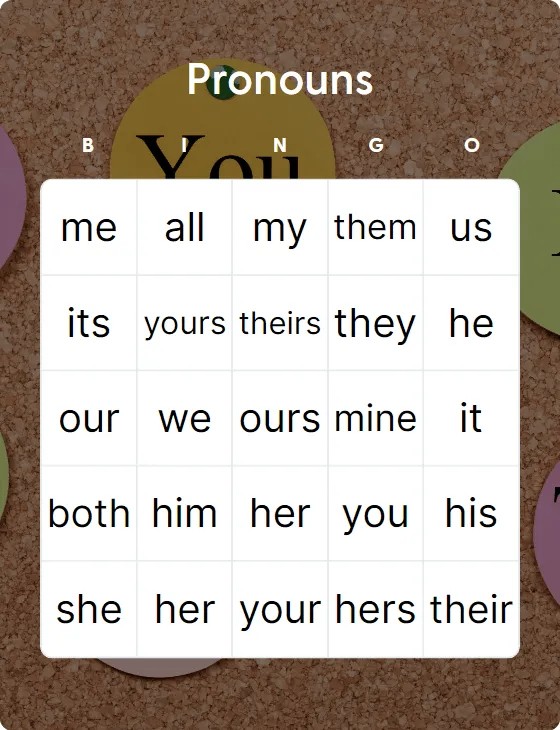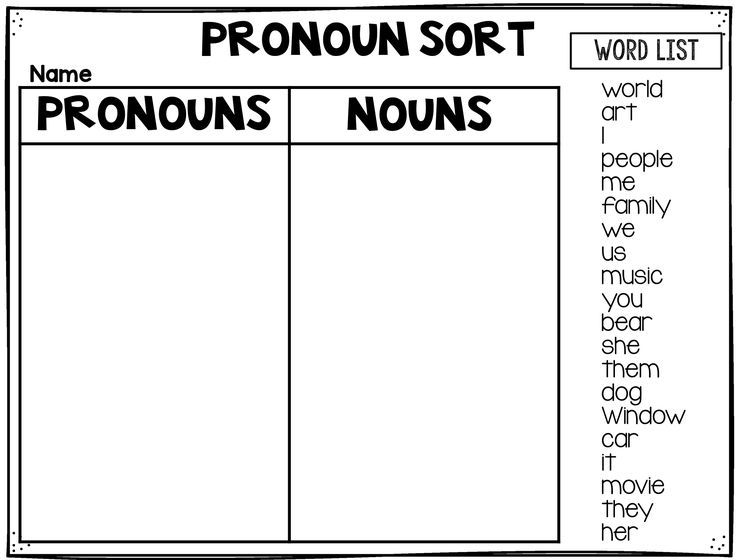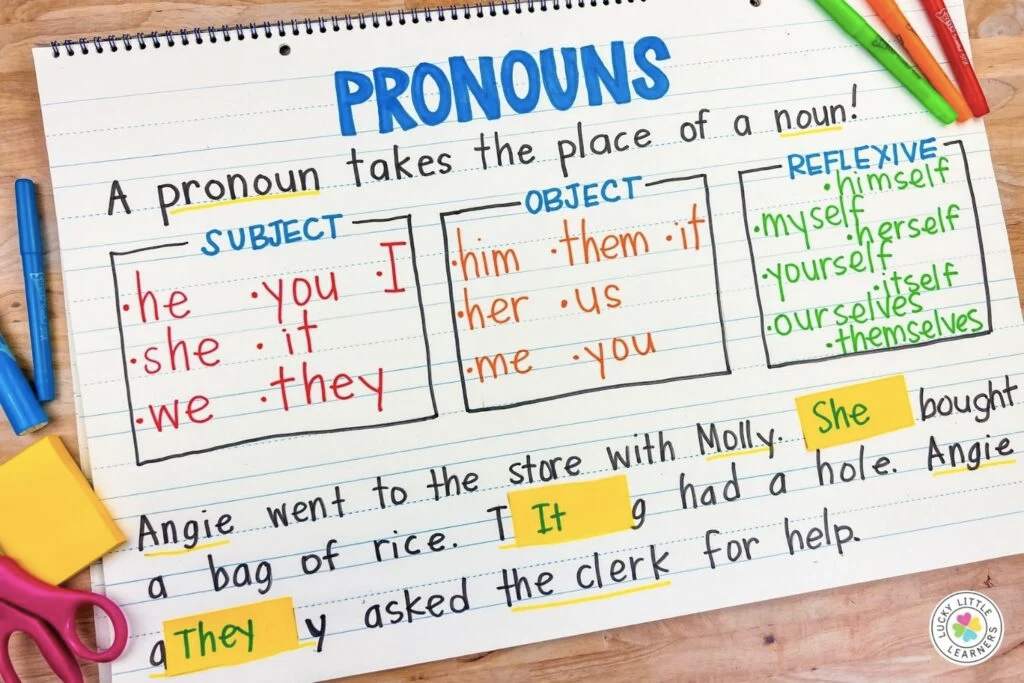Pronouns are words that replace nouns, like “he,” “she,” and “they.” They make sentences sound more natural and help avoid repetition. In this blog, you will learn how to teach pronouns to kids with a simple, step-by-step guide. This approach will make it easy for children to understand and use pronouns correctly in their sentences.
Math & ELA | PreK To Grade 5
Kids see fun.
You see real learning outcomes.
Watch your kids fall in love with math & reading through our scientifically designed curriculum.
Parents, try for free Teachers, use for free
What Should a Child Know Before Learning Pronouns?
- Understanding of basic nouns: Children need to know what nouns are because pronouns replace nouns in sentences. They should be able to identify nouns like “cat,” “John,” and “book.”
- Ability to form simple sentences: Kids should know how to make simple sentences. For example, “The cat is sleeping.” This helps them understand how pronouns can replace nouns in sentences.
- Familiarity with basic grammar concepts: It is important to have a basic understanding of grammar, such as what subjects and objects are. Knowing these concepts helps kids grasp how pronouns fit into sentences and replace nouns correctly.
Related Reading: Best Grammar Games for Kids That are Super Fun!
How to Teach Pronouns in 6 Easy Steps
Step 1: Identify Nouns
Make sure kids understand what nouns are. Nouns are words that name people, animals, places, or things. Examples include “John,” “cat,” “book,” and “school.”
Practice Identifying Nouns: Give kids sentences and ask them to find the nouns. For example, in the sentence “The cat is on the table,” ask them to underline “cat” and “table.” This practice helps them recognize nouns so they can later replace them with pronouns.
Related Reading: Best Common and Proper Noun Activities
Step 2: Introduction to Personal Pronouns
Start with basic personal pronouns: “I,” “you,” “he,” “she,” “it,” “we,” and “they.” Explain which nouns they can replace. For example, “he” can replace “John,” and “she” can replace “Lisa.” Teaching about pronouns like these helps kids understand how to correctly use pronouns.
How to do it:
- Matching Activity: Create a matching activity where kids match pronouns to the nouns they can replace. For example, match “John” to “he” and “Lisa” to “she.” This helps kids practice and remember which pronouns go with which nouns.
- Sentence Substitution: Show sentences with nouns and how to substitute them with pronouns (e.g., “John is playing” becomes “He is playing”).
Begin with these ELA worksheets:
Step 3: Subject and Object Pronouns
Explain that subject pronouns are used as the subject of a sentence, like “I,” “you,” “he,” “she,” “it,” “we,” and “they.” Object pronouns are used as the object of a sentence, like “me,” “you,” “him,” “her,” “it,” “us,” and “them.” For example, in the sentence “She gave him a book,” “She” is a subject pronoun, and “him” is an object pronoun.
How to do it:
- Underline Subject and Object in a Paragraph: Provide a paragraph and ask kids to underline the subject pronouns and circle the object pronouns.
- Fill in the Blanks with Correct Subject and Object Pronouns: Give sentences with blanks and have kids fill in the correct subject and object pronouns.
- Make Sentences Using Subject and Object Pronouns: Ask kids to create their own sentences using both subject and object pronouns.
- Subject and Object Sorting: Provide a list of pronouns and ask kids to sort them into subject and object pronouns categories.
Here is a fun worksheet with all activities packed in one:
Step 4: Next Move to Possessive Pronouns
Explain that possessive pronouns show ownership or belonging. Examples of possessive pronouns are “my,” “your,” “his,” “her,” “its,” “our,” and “their.” For instance, in the sentence “This is my book,” “my” shows that the book belongs to the speaker.
How to do it:
- Provide sentences and have kids identify or fill in the correct possessive pronouns.
Step 5: Reflexive Pronouns
Introduce reflexive pronouns like “myself,” “yourself,” “himself,” “herself,” “itself,” “ourselves,” “yourselves,” and “themselves.” These pronouns are used when the subject and the object of a sentence are the same.
How to teach:
- Fill-in-the-Blank: Provide worksheets with sentences missing reflexive pronouns. Create a worksheet with sentences like “She looked at ___ in the mirror” or “They made lunch for ___.” Ask the kids to fill in the blanks with the correct reflexive pronoun (herself, themselves, etc.).
- Sentence Completion Game: Create a game where kids complete sentences with the correct reflexive pronoun. Prepare sentence strips with missing reflexive pronouns, such as “I hurt ___ while playing” or “He taught ___ to tie his shoes.” Place these strips in a box or bag. Each child takes a turn drawing a strip and completing the sentence aloud.
Begin practicing reflexive pronouns with these fun worksheets:
Step 6: Pronoun Agreement
Teach kids about pronoun-antecedent agreement. This means that pronouns must match the nouns they replace in number and gender. For example, if the noun is singular like “cat,” the pronoun should also be singular, like “it.” If the noun is plural like “dogs,” the pronoun should be plural, like “they.” Similarly, if the noun is “girl,” the pronoun should be “she,” and if the noun is “boy,” the pronoun should be “he.”
Teaching kids these rules ensures they use pronouns correctly, making their sentences clear and grammatically correct. Understanding pronoun agreement is an important part of mastering english pronouns.
Begin with these pronoun-antecedent agreement worksheets:
Pronoun Chart for Kids
| Type of Pronoun | Pronouns | Examples |
|---|---|---|
| Personal Pronouns | Subject Pronouns: I, you, he, she, it, we, theyObject Pronouns: me, you, him, her, it, us, them | Subject Examples: I am happy.Object Examples: She gave me a book. |
| Possessive Pronouns | mine, yours, his, hers, its, ours, theirs | The book is mine.The car is theirs. |
| Reflexive Pronouns | myself, yourself, himself, herself, itself, ourselves, yourselves, themselves | I made it myself.They did it themselves. |
| Demonstrative Pronouns | this, that, these, those | This is my friend.Those are my toys. |
| Interrogative Pronouns | who, whom, whose, which, what | Who is there?What is that? |
| Relative Pronouns | who, whom, whose, which, that | The boy who is running is my brother.The book that you gave me is interesting. |
| Indefinite Pronouns | someone, anyone, everyone, no one, somebody, anybody, everybody, nobody | Someone is at the door.Everybody likes ice cream. |
5 Fun Ways to Teach Pronouns
1. Pronoun Scavenger Hunt
Create a game where kids find and identify pronouns in a story or around the classroom. This is a fun and interactive way to help kids learn pronouns. This is an effective method when teaching pronouns to ESL students, as it combines learning with movement and observation.
2. Pronoun Bingo

Make a bingo game with pronouns instead of numbers. Kids will enjoy marking off the pronouns they hear, which helps reinforce their learning in a playful way. This game is an easy way to teach pronouns through repetition and recognition.
3. Pronoun Sorting Game

Have kids sort words into nouns and pronouns. This simple activity helps kids understand the difference between nouns and pronouns. Teaching pronouns with pictures can make this activity even more engaging, as kids match pictures with the correct pronouns.
4. Role-Playing Scenarios
Use role-playing to practice using pronouns in different contexts. Kids can act out different scenarios using pronouns, making the learning experience fun and memorable. This method is particularly useful for teaching pronouns to ESL students, as it encourages them to use pronouns in conversation.
5. Pronoun Puzzles
Create puzzles where kids match pronouns to pictures or sentences. This hands-on activity helps kids learn through visual and tactile means.
Conclusion
Teaching pronouns to kids can be easy and fun with the right methods. By following this step-by-step guide, you’ll know how to teach pronouns effectively and make learning enjoyable for your students.
Related Reading: What Are Adjectives for Kids? Types, Examples and Activities


































